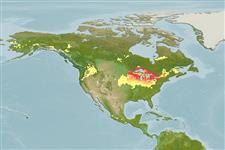Classification / Names
Common names | Synonyms | Catalog of Fishes (gen., sp.) | ITIS | CoL | WoRMS | Cloffa
Actinopterygii (ray-finned fishes) >
Scorpaeniformes (Scorpionfishes and flatheads) >
Cottidae (Sculpins)
Etymology: Cottus: Greek, kottos = a fish (Ref. 45335); bairdii: Named after Spencer Fullerton Baird, first U.S. Fish Commissioner.. More on author: Girard.
Environment / Climate / Range
Ecology
Freshwater; demersal; depth range ? - 16 m (Ref. 1998). Temperate, preferred ?; 59°N - 34°N
North America: widespread with highly disjunct distribution in Canada and USA. The former Blue Ridge race of the Atlantic slope of the Appalachian Mountains is now recognized as a distinct species Cottus caeruleomentum.
Size / Weight / Age
Maturity: Lm ? range ? - ? cm
Max length : 15.0 cm TL male/unsexed; (Ref. 5723); common length : 8.4 cm TL male/unsexed; (Ref. 12193); max. reported age: 2 years (Ref. 12193)
Adults occur in rubble and gravel riffles, less often in sand-gravel runs of headwaters, creeks and small rivers. Also found in springs and their effluents and rocky shores of lakes (Ref. 1998, 10294). Feed mainly on aquatic insect larvae, but also on crustaceans, annelids, fishes, fish eggs, and plant material (Ref. 1998, 10294). Spawn in the spring (Ref. 1998). A male guards the cluster of eggs laid by different females (Ref. 1998). Neither anterolateral glandular groove nor venom gland is present (Ref. 57406).
Male selects a nesting site under a rock of ledge. Male entices a female to enter the nest. Female deposits eggs on the upper surface of the rock and leaves or is driven out of the nest. Eggs are deposited by different females. The male guards the eggs from predators and maintains a natural current flow (Ref. 1998). Also Ref. 53335.
Page, L.M. and B.M. Burr, 1991. A field guide to freshwater fishes of North America north of Mexico. Houghton Mifflin Company, Boston. 432 p. (Ref. 5723)
IUCN Red List Status (Ref. 115185)
CITES (Ref. 94142)
Not Evaluated
Threat to humans
Harmless
Human uses
Tools
Special reports
Download XML
Internet sources
